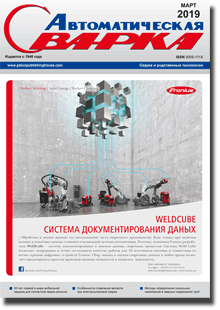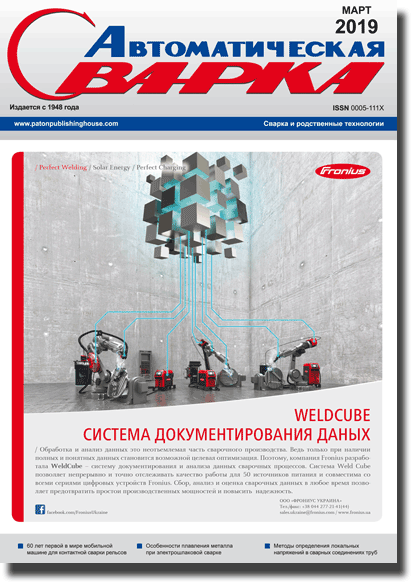| 2019 №03 (08) |
DOI of Article 10.15407/as2019.03.01 |
2019 №03 (02) |

Avtomaticheskaya Svarka (Automatic Welding), #3, 2019, pp. 12-17
Peculiarities of electrode and base metal melting in electroslag welding
I.I. Lychko, K.A. Yushchenko, S.A. Suprun, S.M. Kozulin
E.O. Paton Electric Welding Institute of the NAS of Ukraine. 11 Kazymyr Malevych Str., 03150, Kyiv, Ukraine. E-mail: office@paton.kiev.ua
Results of experimental studies of the connection between the processes proceeding in the electrode wire melting zone and electric parameters of the mode of electroslag welding are described. The experimental procedure envisaged electroslag welding of samples from 09G2S steel 60 mm thick in modes identical to those, used earlier for photographing and filming the welding zone through an optically transparent medium. Hall sensor, ATsP E-140 module and Power Graph software were applied for high-speed recording of electric parameters of the mode (10 thous. records per second). Measurements of slag pool temperature near the electrode wire melting zone were taken simultaneously. Analysis and comparison of visual observations of the welding zone through an optically transparent medium with the characteristics of electroslag welding mode (Uw, Iw, Vw) were performed, confirming the cyclic existence of an energy nugget in the molten slag between the electrode wire and liquid metal, formed under the impact of electric potential between the base and electrode metal. 9 Ref., 4 Fig.
Keywords: electroslag welding, slag pool, interelectrode gap, high-speed recoding of electric parameters of the mode, active zone, energy nugget, plasma-type discharge, melting and transfer of liquid metal, high-speed photographing and filming
Received: 15.11.2018
Published: 20.02.2019
References
1. Voloshkevich, G.Z. (1955) X-ray investigation of electrode melting and metal transfer. In: Problems of electric arc and resistance welding. Moscow, Mashgiz, 292-300 [in Russian].2. Voloshkevich, G.Z. (1958) Electrode melting and metal transfer in electroslag welding. Avtomatich. Svarka, 10, 14-21 [in (1980) Electroslag welding and surfacing. Ed. by B.E. Paton. Moscow, Mashinostroenie [in Russian].
3. Ando, A., Nakata, S., Wada, H. (1970) Studies on the electroslag welding (Report 111). J. Jap. Weld. Soc., 40(11), 1104-1110. https://doi.org/10.2207/qjjws1943.40.1104
4. Kaluc, E., Taban, E., Dhooge, A. (2006) Electroslag welding process and industrial applications. Metal Dunyasi, Ocak 2006 Sayi: 152, Yil: 13, Sayfa, 100-104 [in Turkish].
5. Brandi, S.D., Liu, S., Thomas, R.D. (2012) Electroslag and electrogas welding. AWS Welding Handbook, 6A, 365-379. https://doi.org/10.31399/asm.hb.v06a.a0005591
6. Konigsmark, J. (1970) Direct observation of electroslag process at welding with wire electrode with diameter of 3.15 mm. Zvaranie, 19(9-10), 265-269 [in Slovak].
7. Dudko, D.A., Voloshkevich, G.Z., Sushchuk-Slyusarenko, I.I., Lychko, I.I. (1971) Study of electroslag process using filming and photography through transparent medium. Avtomatich. Svarka, 2, 15-17 [in Russian].
8. Paton, B.E., Lychko, I.I., Yushchenko, K.A. et al. (2013) Melting of electrode and base metal in electroslag welding. The Paton Welding J., 7, 31-38.
The cost of subscription/purchase order journals or individual articles
| Journal/Currency | Annual Set | 1 issue printed |
1 issue |
one article |
| TPWJ/USD | 384 $ | 32 $ | 26 $ | 13 $ |
| TPWJ/EUR | 348 € | 29 € | 24 € | 12 € |
| TPWJ/UAH | 7200 UAH | 600 UAH | 600 UAH | 280 UAH |
| AS/UAH | 1800 UAH | 300 UAH | 300 UAH | 150 UAH |
| AS/USD | 192 $ | 32 $ | 26 $ | 13 $ |
| AS/EUR | 180 € | 30 € | 25 € | 12 € |
| SEM/UAH | 1200 UAH | 300 UAH | 300 UAH | 150 UAH |
| SEM/USD | 128 $ | 32 $ | 26 $ | 13 $ |
| SEM/EUR | 120 € | 30 € | 25 € | 12 € |
| TDNK/UAH | 1200 UAH | 300 UAH | 300 UAH | 150 UAH |
| TDNK/USD | 128 $ | 32 $ | 26 $ | 13 $ |
| TDNK/EUR | 120 € | 30 € | 25 € | 15 € |
AS = «Automatic Welding» - 6 issues per year;
TPWJ = «PATON WELDING JOURNAL» - 12 issues per year;
SEM = «Electrometallurgy Today» - 4 issues per year;
TDNK = «Technical Diagnostics and Non-Destructive Testing» - 4 issues per year.





